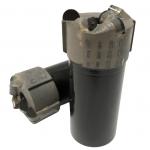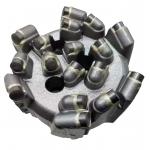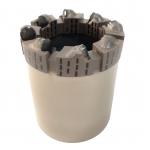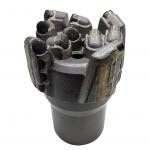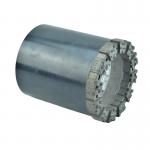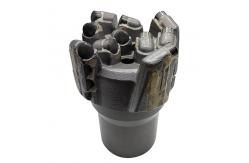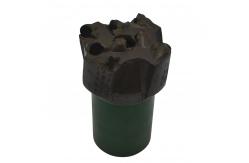Optimal Hydraulics for Efficient Cooling Effective in Composite
Formations PDC Drill Bit Some more details on different aspects related to drilling and PDC
(Polycrystalline Diamond Compact) drill bits: PDC Bit Cutting Structure: The cutting structure of a PDC drill bit
refers to the arrangement, shape, and orientation of the individual
cutters on the bit. The cutting structure is designed to optimize
cutting efficiency, stability, and durability. Different cutting
structure configurations are used based on the formation being
drilled and the desired drilling objectives. Common cutting
structure designs include single-sided, double-sided, and
multi-sided arrangements, as well as staggered or spiral patterns. Hybrid Bits: Hybrid drill bits combine different cutting
technologies, such as PDC cutters and roller cones, in a single bit
design. These bits leverage the strengths of each cutting
technology to improve performance in specific drilling conditions.
For example, hybrid bits may use PDC cutters for efficient drilling
through soft formations while incorporating roller cones for
enhanced performance in harder formations. Hybrid bits offer
versatility and are effective in drilling through formations with
varying hardness. PDC Bit Run Life: The run life of a PDC drill bit refers to the
duration the bit remains in service before it needs to be replaced
or repaired. Run life can vary depending on factors such as
drilling conditions, formation characteristics, drilling
parameters, bit design, and cutter quality. Operators monitor the
run life of PDC bits to optimize drilling efficiency and reduce
downtime associated with bit changes. Enhancements in cutter
technology and bit design have led to longer run life for PDC bits
in many drilling applications. Cuttings Removal: Effective removal of drilled cuttings from the
wellbore is crucial for efficient drilling operations. PDC bits are
designed with nozzles strategically placed around the bit to
deliver drilling fluid and facilitate cuttings transport to the
surface. The design and placement of these nozzles impact the
hydraulics and cleaning efficiency of the bit. Proper cuttings
removal helps maintain drilling performance, prevents bit balling,
and reduces the risk of hole cleaning issues. PDC Bit Optimization: PDC bit optimization involves selecting the
most suitable bit design and cutter configuration for specific
drilling applications. Optimization considers factors such as
formation characteristics, drilling parameters, drilling
objectives, and cost considerations. Advanced software tools and
algorithms are employed to analyze historical drilling data,
formation analysis, and real-time drilling parameters to recommend
the optimal PDC bit design. Optimization helps improve drilling
efficiency, reduce drilling costs, and enhance overall well
productivity. PDC Bit Wear Monitoring: Monitoring the wear of PDC drill bits is
essential to assess their performance and determine when to replace
or repair them. Various techniques are used to measure and monitor
bit wear, including visual inspections, cutter wear analysis, and
advanced downhole data measurements. Operators utilize wear
monitoring to track the condition of the bit, identify potential
issues, and make informed decisions regarding bit changes or
repairs to maintain drilling efficiency. PDC Bit Repair and Refurbishment: PDC drill bits can undergo repair
and refurbishment to extend their operational life and reduce
overall costs. Bit repair services involve replacing or
reconditioning worn or damaged cutters, restoring gauge diameter,
repairing body damage, and improving hydraulic performance. Some
manufacturers and service providers offer specialized facilities
and expertise for PDC bit repair, allowing operators to maximize
the value and lifespan of their bits. PDC Bit Innovations: Ongoing research and development efforts in
the drilling industry continue to drive innovations in PDC bit
technology. These innovations aim to improve drilling performance,
enhance durability, and address specific drilling challenges.
Advancements include the development of enhanced cutter materials
with improved wear resistance and thermal stability, innovative
cutter geometries for optimized cutting efficiency, novel bit
designs for specific applications, and the integration of sensors
for real-time downhole monitoring. PDC Bit Testing and Evaluation: PDC drill bits undergo rigorous
testing and evaluation to assess their performance, durability, and
reliability. Testing involves laboratory experiments, field trials,
and simulated drilling operations to evaluate factors such as ROP,
bit life, vibration resistance, cutter wear, and hydraulic
performance. These tests help manufacturers refine their designs,
validate performance claims, and provide operators with reliable
performance data to make informed bit selections. PDC Bit Standardization: The drilling industry has established
standards and specifications for PDC drill bits to ensure quality,
consistency, and compatibility. These standards cover various
aspects such as cutter specifications, bit design criteria,
performance metrics, and testing procedures. Standardization
promotes interoperability, facilitates bit selection, and provides
a benchmark for comparing different bit models and manufacturers.
These additional details offer further insights into the design,
performance, optimization, and advancements in PDC drill bits.
Understanding these aspects can help operators make informed
decisions, maximize drilling efficiency, and achieve better overall
drilling outcomes. FAQ: 1. Q: Can PDC bits be used for drilling in limestone with chert
nodules formations?
A: PDC bits can be used for drilling in limestone with chert
nodules formations. However, cutter selection and bit design should
consider the presence of hard chert nodules and potential bit
damage. 2. Q: Can PDC bits be used for drilling in claystone with sandstone
interbeds formations?
A: PDC bits can be used for drilling in claystone with sandstone
interbeds formations. However, designs that address the varying
rock types and provide efficient cuttings removal are important. 3. Q: Can PDC bits be used for drilling in fractured shale
formations?
A: PDC bits can be used for drilling in fractured shale formations.
However, cutter selection and bit design should consider the
presence of fractures and potential for cutter damage or loss. 4. Q: Can PDC bits be used for drilling in limestone with
fossilized reefs formations?
A: PDC bits can be used for drilling in limestone with fossilized
reefs formations. However, designs that address the presence of
hard reef structures and prevent bit damage are important. 5. Q: Can PDC bits be used for drilling in volcanic breccia
formations?
A: PDC bits can be used for drilling in volcanic breccia
formations. However, cutter selection and bit design should
consider the presence of fragmented volcanic rocks and potential
bit damage. |
